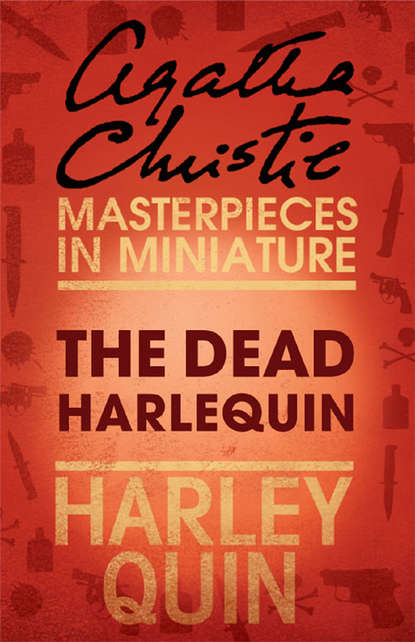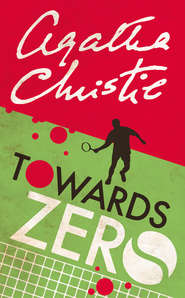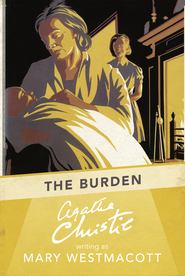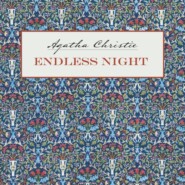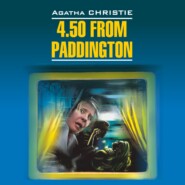По всем вопросам обращайтесь на: info@litportal.ru
(©) 2003-2025.
✖
The Dead Harlequin: An Agatha Christie Short Story
Автор
Год написания книги
2018
Настройки чтения
Размер шрифта
Высота строк
Поля
The Dead Harlequin: An Agatha Christie Short Story
Agatha Christie
A classic Agatha Christie short story, available individually for the first time as an ebook.When Mr. Satterthswaite visits a new exhibit at the Harchester Galleries there is one painting with a male figure that bares a more than unusual likeness to a mysterious acquaintance of his, a Mr. Quin. And with one bold move purchases the canvas on the spot, and in another invites the artist of ‘The Dead Harlequin’ to dine with him that night. The dinner gets off on the wrong foot with the artist emphatically disagreeing with most points and an empty place at the table ready for the mysterious Mr. Quin to arrive. Conversation soon turns to the setting of ‘The Dead Harlequin,’ the doomed and ghostly house, Charnley, where so many have perished under tragic circumstances. But when a new guest is announced, it is not the expected Mr. Quin, but, famed stage comic actress Aspasia Glen, and she wants, above all else, that very painting. But, in the very moment he begins to explain she can’t have it a frantic telephone call from Alix Charnley herself interrupts them with the very same request. What is the meaning of the painting, and can it shed any light upon the grave happenings at Charnley.
The Dead Harlequin
A Short Story
by Agatha Christie
Copyright
Published by HarperCollinsPublishers Ltd 1 London Bridge Street London SE1 9GF
www.harpercollins.co.uk (http://www.harpercollins.co.uk)
Copyright © 2011 Agatha Christie Ltd.
All rights reserved under International and Pan-American Copyright Conventions. By payment of the required fees, you have been granted the nonexclusive, nontransferable right to access and read the text of this e-book on-screen. No part of this text may be reproduced, transmitted, downloaded, decompiled, reverse-engineered, or stored in or introduced into any information storage and retrieval system, in any form or by any means, whether electronic or mechanical, now known or hereinafter invented, without the express written permission of HarperCollins e-books.
EPub Edition © 2011 ISBN: 9780007452101
Version: 2017-04-18
Contents
Cover (#u4c59e19f-bb97-55a2-9fca-b534da48fa97)
Title Page (#u0178cb24-8cf1-578c-b2f0-5e9e1f2c9ee4)
Copyright
The Dead Harlequin
Related Products (#litres_trial_promo)
About the Publisher (#litres_trial_promo)
The Dead Harlequin
‘The Dead Harlequin’ was first published in Grand Magazine, March 1929.
Mr Satterthwaite walked slowly up Bond Street enjoying the sunshine. He was, as usual, carefully and beautifully dressed, and was bound for the Harchester Galleries where there was an exhibition of the paintings of one Frank Bristow, a new and hitherto unknown artist who showed signs of suddenly becoming the rage. Mr Satterthwaite was a patron of the arts.
As Mr Satterthwaite entered the Harchester Galleries, he was greeted at once with a smile of pleased recognition.
‘Good morning, Mr Satterthwaite, I thought we should see you before long. You know Bristow’s work? Fine – very fine indeed. Quite unique of its kind.’
Mr Satterthwaite purchased a catalogue and stepped through the open archway into the long room where the artist’s works were displayed. They were water colours, executed with such extraordinary technique and finish that they resembled coloured etchings. Mr Satterthwaite walked slowly round the walls scrutinizing and, on the whole, approving. He thought that this young man deserved to arrive. Here was originality, vision, and a most severe and exacting technique. There were crudities, of course. That was only to be expected – but there was also something closely allied to genius. Mr Satterthwaite paused before a little masterpiece representing Westminster Bridge with its crowd of buses, trams and hurrying pedestrians. A tiny thing and wonderfully perfect. It was called, he noted, The Ant Heap. He passed on and quite suddenly drew in his breath with a gasp, his imagination held and riveted.
The picture was called The Dead Harlequin. The forefront of it represented a floor of inlaid squares of black and white marble. In the middle of the floor lay Harlequin on his back with his arms outstretched, in his motley of black and red. Behind him was a window and outside that window, gazing in at the figure on the floor, was what appeared to be the same man silhouetted against the red glow of the setting sun.
The picture excited Mr Satterthwaite for two reasons, the first was that he recognized, or thought that he recognized, the face of the man in the picture. It bore a distinct resemblance to a certain Mr Quin, an acquaintance whom Mr Satterthwaite had encountered once or twice under somewhat mystifying circumstances.
‘Surely I can’t be mistaken,’ he murmured. ‘If it is so – what does it mean?’
For it had been Mr Satterthwaite’s experience that every appearance of Mr Quin had some distinct significance attaching to it.
There was, as already mentioned, a second reason for Mr Satterthwaite’s interest. He recognized the scene of the picture.
‘The Terrace Room at Charnley,’ said Mr Satterthwaite. ‘Curious – and very interesting.’
He looked with more attention at the picture, wondering what exactly had been in the artist’s mind. One Harlequin dead on the floor, another Harlequin looking through the window – or was it the same Harlequin? He moved slowly along the walls gazing at other pictures with unseeing eyes, with his mind always busy on the same subject. He was excited. Life, which had seemed a little drab this morning, was drab no longer. He knew quite certainly that he was on the threshold of exciting and interesting events. He crossed to the table where sat Mr Cobb, a dignitary of the Harchester Galleries, whom he had known for many years.
‘I have a fancy for buying no. 39,’ he said, ‘if it is not already sold.’
Mr Cobb consulted a ledger.
‘The pick of the bunch,’ he murmured, ‘quite a little gem, isn’t it? No, it is not sold.’ He quoted a price. ‘It is a good investment, Mr Satterthwaite. You will have to pay three times as much for it this time next year.’
‘That is always said on these occasions,’ said Mr Satterthwaite, smiling.
‘Well, and haven’t I been right?’ demanded Mr Cobb. ‘I don’t believe if you were to sell your collection, Mr Satterthwaite, that a single picture would fetch less than you gave for it.’
‘I will buy this picture,’ said Mr Satterthwaite. ‘I will give you a cheque now.’
‘You won’t regret it. We believe in Bristow.’
‘He is a young man?’
‘Twenty-seven or eight, I should say.’
‘I should like to meet him,’ said Mr Satterthwaite. ‘Perhaps he will come and dine with me one night?’
‘I can give you his address. I am sure he would leap at the chance. Your name stands for a good deal in the artistic world.’
‘You flatter me,’ said Mr Satterthwaite, and was going on when Mr Cobb interrupted:
‘Here he is now. I will introduce you to him right away.’
He rose from behind his table. Mr Satterthwaite accompanied him to where a big, clumsy young man was leaning against the wall surveying the world at large from behind the barricade of a ferocious scowl.
Mr Cobb made the necessary introductions and Mr Satterthwaite made a formal and gracious little speech.
‘I have just had the pleasure of acquiring one of your pictures – The Dead Harlequin.’
‘Oh! Well, you won’t lose by it,’ said Mr Bristow ungraciously. ‘It’s a bit of damned good work, although I say it.’
‘I can see that,’ said Mr Satterthwaite. ‘Your work interests me very much, Mr Bristow. It is extraordinarily mature for so young a man. I wonder if you would give me the pleasure of dining with me one night? Are you engaged this evening?’
Agatha Christie
A classic Agatha Christie short story, available individually for the first time as an ebook.When Mr. Satterthswaite visits a new exhibit at the Harchester Galleries there is one painting with a male figure that bares a more than unusual likeness to a mysterious acquaintance of his, a Mr. Quin. And with one bold move purchases the canvas on the spot, and in another invites the artist of ‘The Dead Harlequin’ to dine with him that night. The dinner gets off on the wrong foot with the artist emphatically disagreeing with most points and an empty place at the table ready for the mysterious Mr. Quin to arrive. Conversation soon turns to the setting of ‘The Dead Harlequin,’ the doomed and ghostly house, Charnley, where so many have perished under tragic circumstances. But when a new guest is announced, it is not the expected Mr. Quin, but, famed stage comic actress Aspasia Glen, and she wants, above all else, that very painting. But, in the very moment he begins to explain she can’t have it a frantic telephone call from Alix Charnley herself interrupts them with the very same request. What is the meaning of the painting, and can it shed any light upon the grave happenings at Charnley.
The Dead Harlequin
A Short Story
by Agatha Christie
Copyright
Published by HarperCollinsPublishers Ltd 1 London Bridge Street London SE1 9GF
www.harpercollins.co.uk (http://www.harpercollins.co.uk)
Copyright © 2011 Agatha Christie Ltd.
All rights reserved under International and Pan-American Copyright Conventions. By payment of the required fees, you have been granted the nonexclusive, nontransferable right to access and read the text of this e-book on-screen. No part of this text may be reproduced, transmitted, downloaded, decompiled, reverse-engineered, or stored in or introduced into any information storage and retrieval system, in any form or by any means, whether electronic or mechanical, now known or hereinafter invented, without the express written permission of HarperCollins e-books.
EPub Edition © 2011 ISBN: 9780007452101
Version: 2017-04-18
Contents
Cover (#u4c59e19f-bb97-55a2-9fca-b534da48fa97)
Title Page (#u0178cb24-8cf1-578c-b2f0-5e9e1f2c9ee4)
Copyright
The Dead Harlequin
Related Products (#litres_trial_promo)
About the Publisher (#litres_trial_promo)
The Dead Harlequin
‘The Dead Harlequin’ was first published in Grand Magazine, March 1929.
Mr Satterthwaite walked slowly up Bond Street enjoying the sunshine. He was, as usual, carefully and beautifully dressed, and was bound for the Harchester Galleries where there was an exhibition of the paintings of one Frank Bristow, a new and hitherto unknown artist who showed signs of suddenly becoming the rage. Mr Satterthwaite was a patron of the arts.
As Mr Satterthwaite entered the Harchester Galleries, he was greeted at once with a smile of pleased recognition.
‘Good morning, Mr Satterthwaite, I thought we should see you before long. You know Bristow’s work? Fine – very fine indeed. Quite unique of its kind.’
Mr Satterthwaite purchased a catalogue and stepped through the open archway into the long room where the artist’s works were displayed. They were water colours, executed with such extraordinary technique and finish that they resembled coloured etchings. Mr Satterthwaite walked slowly round the walls scrutinizing and, on the whole, approving. He thought that this young man deserved to arrive. Here was originality, vision, and a most severe and exacting technique. There were crudities, of course. That was only to be expected – but there was also something closely allied to genius. Mr Satterthwaite paused before a little masterpiece representing Westminster Bridge with its crowd of buses, trams and hurrying pedestrians. A tiny thing and wonderfully perfect. It was called, he noted, The Ant Heap. He passed on and quite suddenly drew in his breath with a gasp, his imagination held and riveted.
The picture was called The Dead Harlequin. The forefront of it represented a floor of inlaid squares of black and white marble. In the middle of the floor lay Harlequin on his back with his arms outstretched, in his motley of black and red. Behind him was a window and outside that window, gazing in at the figure on the floor, was what appeared to be the same man silhouetted against the red glow of the setting sun.
The picture excited Mr Satterthwaite for two reasons, the first was that he recognized, or thought that he recognized, the face of the man in the picture. It bore a distinct resemblance to a certain Mr Quin, an acquaintance whom Mr Satterthwaite had encountered once or twice under somewhat mystifying circumstances.
‘Surely I can’t be mistaken,’ he murmured. ‘If it is so – what does it mean?’
For it had been Mr Satterthwaite’s experience that every appearance of Mr Quin had some distinct significance attaching to it.
There was, as already mentioned, a second reason for Mr Satterthwaite’s interest. He recognized the scene of the picture.
‘The Terrace Room at Charnley,’ said Mr Satterthwaite. ‘Curious – and very interesting.’
He looked with more attention at the picture, wondering what exactly had been in the artist’s mind. One Harlequin dead on the floor, another Harlequin looking through the window – or was it the same Harlequin? He moved slowly along the walls gazing at other pictures with unseeing eyes, with his mind always busy on the same subject. He was excited. Life, which had seemed a little drab this morning, was drab no longer. He knew quite certainly that he was on the threshold of exciting and interesting events. He crossed to the table where sat Mr Cobb, a dignitary of the Harchester Galleries, whom he had known for many years.
‘I have a fancy for buying no. 39,’ he said, ‘if it is not already sold.’
Mr Cobb consulted a ledger.
‘The pick of the bunch,’ he murmured, ‘quite a little gem, isn’t it? No, it is not sold.’ He quoted a price. ‘It is a good investment, Mr Satterthwaite. You will have to pay three times as much for it this time next year.’
‘That is always said on these occasions,’ said Mr Satterthwaite, smiling.
‘Well, and haven’t I been right?’ demanded Mr Cobb. ‘I don’t believe if you were to sell your collection, Mr Satterthwaite, that a single picture would fetch less than you gave for it.’
‘I will buy this picture,’ said Mr Satterthwaite. ‘I will give you a cheque now.’
‘You won’t regret it. We believe in Bristow.’
‘He is a young man?’
‘Twenty-seven or eight, I should say.’
‘I should like to meet him,’ said Mr Satterthwaite. ‘Perhaps he will come and dine with me one night?’
‘I can give you his address. I am sure he would leap at the chance. Your name stands for a good deal in the artistic world.’
‘You flatter me,’ said Mr Satterthwaite, and was going on when Mr Cobb interrupted:
‘Here he is now. I will introduce you to him right away.’
He rose from behind his table. Mr Satterthwaite accompanied him to where a big, clumsy young man was leaning against the wall surveying the world at large from behind the barricade of a ferocious scowl.
Mr Cobb made the necessary introductions and Mr Satterthwaite made a formal and gracious little speech.
‘I have just had the pleasure of acquiring one of your pictures – The Dead Harlequin.’
‘Oh! Well, you won’t lose by it,’ said Mr Bristow ungraciously. ‘It’s a bit of damned good work, although I say it.’
‘I can see that,’ said Mr Satterthwaite. ‘Your work interests me very much, Mr Bristow. It is extraordinarily mature for so young a man. I wonder if you would give me the pleasure of dining with me one night? Are you engaged this evening?’





